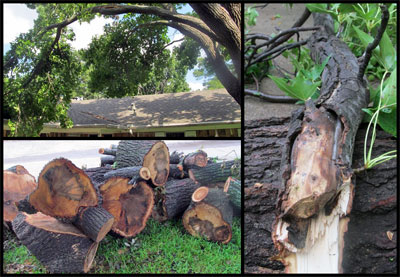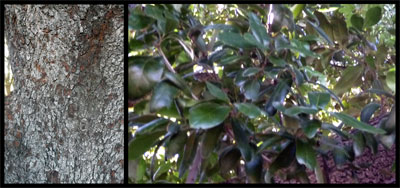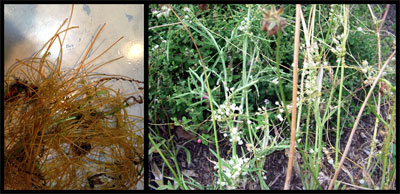Question and Answer — August 2013
This is the most-read part of e-gardens, and you can be involved. All it takes is an e-mailed question AND a photo to go with it. Neil can give you the best possible help if you will also mention your city. It’s worthy of note that every question submitted below had the city listed! Way to go, team! Neil chooses the six or eight questions he feels will be of widest reader interest and answers them here every month. Plant ID questions are usually of interest only to the person with the plant, so those rarely are chosen. Here are this month’s Q’s and Neil’s A’s.
Question: We had a sweetgum removed recently after portions of it split. The tree service people said they thought it had been hit by lightning. Do you think that was correct? Would the mulch from the grinder be okay to use? C.U., Plano.
Answer: Lightning perhaps. However, the bark that was peeling away from the one branch looks like there might have been some form of active decay or other vascular issue. The stained tissues in the cross sections would bear that out. If lightning caused it, it would have been a good while ago. Sweetgums in general just aren’t well suited to the Blackland Prairie soils. The mulch should be just fine around your other plants. Better yet, compost it for six to 10 months.
Question: My bur oak is four years old, and it’s about 10 feet tall. The leaves are lacy on both top and bottom surfaces. What should I do? J.B., Missouri City.
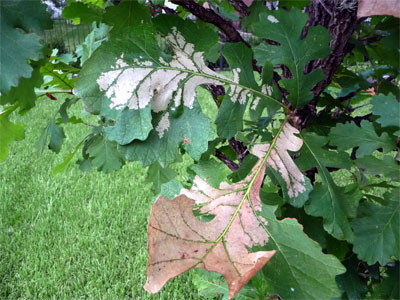
Answer: Don’t worry about it. This is damage done by sawflies. They devour leaf tissues from between the veins as they skeletonize sections of the tree. I have them on a couple of my bur oak trees. They do no permanent harm, and there’s not much you can do anyway, especially this late in the year. If you wish, apply Imidacloprid systemic insecticide as a soil drench next May.
Question: Thanks for suggesting the tree wrap for my oak. How long should I leave it in place? E.H., Colleyville.
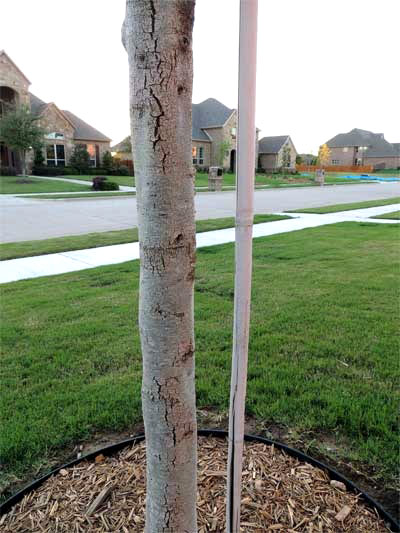
Answer: Trunk wrap should be left in place until the canopy of leaves shades the trunk during the hottest part of midday. That’s usually a couple of years. In your case, I would suggest unwrapping and checking the trunk every few months, since there is already damage present, just to be sure no decay sets in. Good luck with it!
Question: Is this Rose Rosette Virus on my dad’s rose? C.S., McKinney.
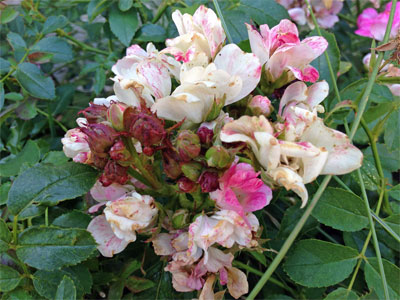
Answer: Yes. Any plants with this sort of clubby growth should be removed immediately. Microscopic mites spread the virus, and we have no means of controlling the problem. I’m very sorry for that news. This has not been a pleasant year for rose growers.
Question: Why would my tomato plants have faded so early? They bloomed, but few of the flowers set fruit. Those that developed had big brown spots on the bottoms. Also, my cucumbers didn’t do well. I watered them some also. I don’t understand why this happened to my garden. T.W., Leonard.

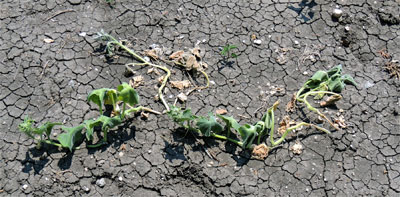
Answer: This was not a good year for tomatoes. Late freezes through April put things way behind schedule. Large-fruiting varieties will not set fruit when temperatures are above 90, so that may be part of the problem, too. For small types, if there is little wind movement, you’ll want to thump the flower clusters to jar the pollen loose. The browned bottoms on the tomatoes is a problem called blossom-end rot. It’s an environmental issue caused by letting the plants get too dry between waterings. Both the tomato and cucumber would have benefitted from deep soakings and a 1-inch layer of mulch.
Question: Why would my wax myrtle have developed brown leaves through this summer? L., Denton.
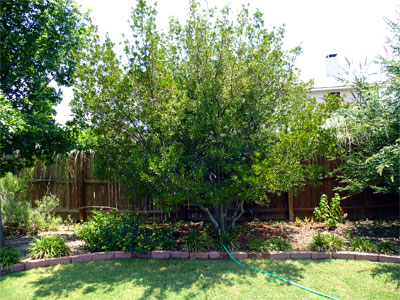
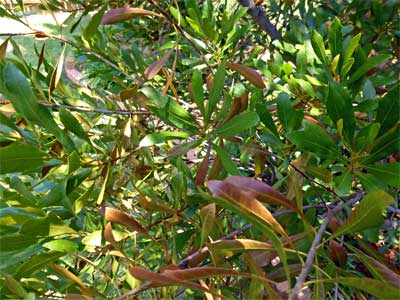
Answer: Wax myrtles are native to wetter, more humid areas than Denton. This is almost assuredly a result of the weather. Unfortunately, it often gets worse, to the point that branches begin to die due primarily to the environmental stresses (not insects or diseases). Hopefully that won’t happen to your plant.
Question: What will kill this vining weed with the burs? I’ve asked my husband just to burn off the yard to get rid of it! J.M., Decatur.
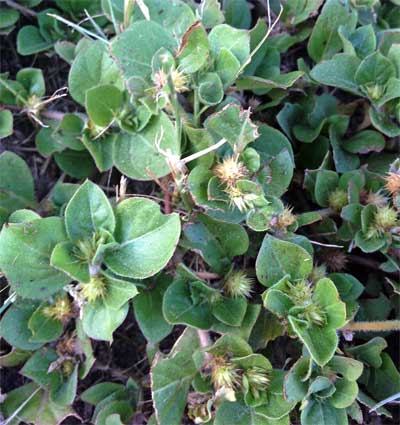
Answer: That would be extreme (and dangerous) (and illegal). Apply a broadleafed weedkiller (containing 2,4-D) to the foliage while it is growing actively. Use a pump sprayer as opposed to hose-end, so the droplets will be fine. Include one drop of liquid dishwashing detergent per gallon of spray to hold it on the plants’ leaves.
Question: Our ‘Dynamite’ crape myrtles are four years old, but this year they have not flowered nearly as well as the other years. What would you do? M. and R. Z., Colleyville.

Answer: Next April and again in June, apply an all-nitrogen fertilizer to the plants. That’s probably about the same time that your lawn is getting its nourishment, and the same fertilizer will be perfect – as long as there is no weedkiller in it. I might suggest removing one or two of the outermost trunks to maintain a slightly more upright habit with the plants. This year got off to an odd start for crape myrtles, with the repeated cold spells in mid-spring slowing their early growth.
Question: How can we eliminate this vine that invades and takes over? We’ve tried pruning and digging, but it always seems like there is more of it left behind. L. and S., Oak Cliff/Dallas.
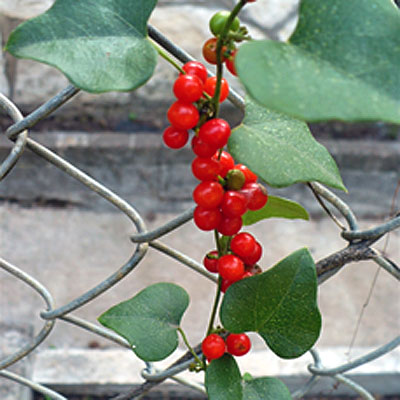
Answer: As native plants go, this is a really pretty one called snailseed vine. But the fruit doesn’t last very long, and the vine itself is obnoxious. I have a lot of it in my gardens, too, and I’ve found that tracing the stems back and digging them with a sharpshooter spade gives the best and most complete control. A broadleafed weedkiller (2,4-D) would probably work, but I have too many other broadleafed perennials that would be harmed by the spray.
Question: What can I use to kill the caterpillars on my Texas mountain laurel? M.D., Waxahachie.
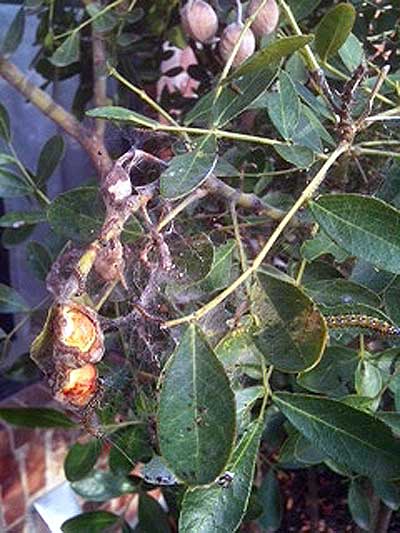
Answer: These are Genista caterpillars, and they are indeed regular visitors to Texas mountain laurels. Systemic insecticides work well, as will sprays with Sevin or B.t. However, you may want to include a drop of a liquid dishwashing detergent with the spray to help it penetrate into the webs.
Question: We grew this Chinese pistachio from a seedling. Will it ever grow to look like our other pistachios, or should we just replace it? B., Kerrville.
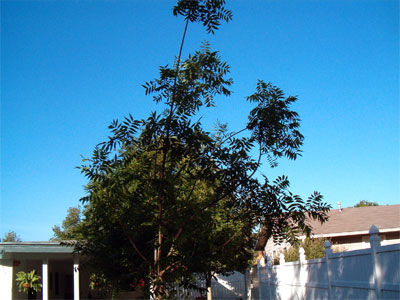
Answer: I’ve always contended that young Chinese pistachios are like gangly puppies – they grow into their good looks. If this were my tree, I’d definitely try to save it. It looks very healthy and vigorous, just oddly shaped. I would use a pole pruner to clip the three or four long branches back into the canopy. You might want to wait to do this pruning until winter, when you can see the branch angles clearly. The tree will catch up with itself within just a couple of years.
Question: I think this is some type of live oak. We returned from vacation to see little chips of bark missing from its trunk. Is this anything we should worry about? T., Irving.
Answer: It is a live oak, and the leaves look so vigorous that there shouldn’t be too much cause for concern. Watch the areas where the bark has sloughed off to see if they expand. It’s probably just normal bark drop brought on by new growth from spring and early summer.
Question: This orange weedeater-cord-like stuff was growing on my wildflowers. It has small white flowers. I’ve removed as much as I could, but it still seems to be there. What is it, and what can I do for it? C.C., Carrollton.
Answer: This is dodder. Although it’s a flowering plant, it is parasitic and undesirable. Keep removing it until you have eliminated it. It’s not uncommon to see masses of it piled up along roadsides in spring. Keep it away from your cultivated flowers and other landscape plants.
Question: Why would my red oak be losing chunks of bark? The tree is 17 years old, and looking at it, you wouldn’t notice anything out of the ordinary. C., Mart.
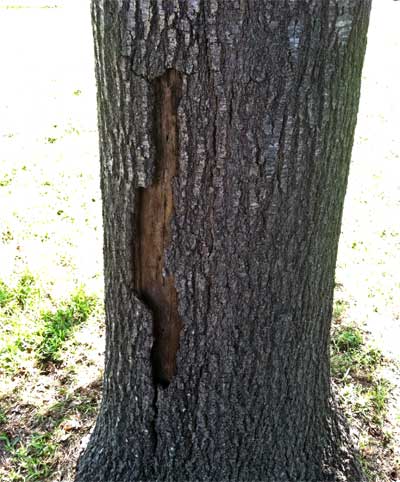
Answer: This is Hypoxylon canker. We’ve seen a great deal of it over the past several years, due in large part to the drought of 2011. If your tree is maintaining its vigor, it will probably fend for itself quite well. Just keep its growing conditions as optimum as possible. If the problem gets any worse, call in a certified arborist.
Question: I’m trying gourds for the first time. In spite of the healthy vines, I have flowers but no fruit. Assuming them to be related to squash and cucumbers, I tried using the male flowers to pollinate the female flowers, but I do not have female flowers. What can I do, or am I just overly anxious? L.C., McKinney
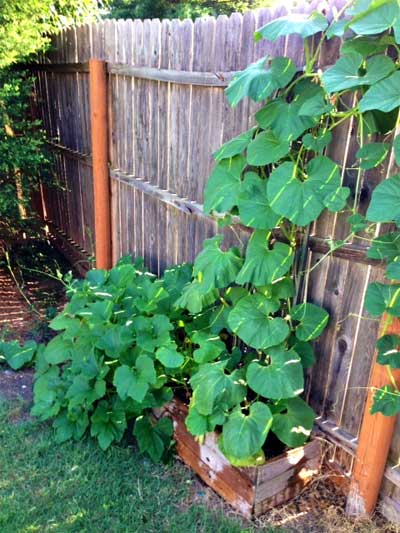
Answer: It’s typical for cucurbits, including gourds, to produce male flowers for a couple of weeks before female flowers show up. I suppose that’s nature’s way of making sure there is pollen available. By the time you’re reading this, hopefully your problems will have been resolved. You are correct in the way you wanted to address the problem. Good luck! Hope it has worked by now.
Question: I know my mums need to be getting ready for their fall flowers, but it was difficult to trim off pretty flowers in June. What should I do other years, and when should I do it? S.S., Paris.

Answer: At some point in late spring or early summer, mums that are blooming in their off-season will reach what is called “heat delay.” Buds fail to open any farther, and flowers remain pretty much static in place. That’s time to trim the plants back by half and remove the flower stems. You can enjoy the flowers indoors for a couple of weeks. Apply a high-nitrogen plant food to stimulate new growth over the summer. Mums measure the length of the dark period at night as a means of determining when it’s time to flower. They receive the same night lengths in spring as they do in fall, hence the spring flowering season. Mums that normally bloom much later in the fall won’t do this.
Question: Why are my red crape myrtles producing white petals? L.C., McKinney
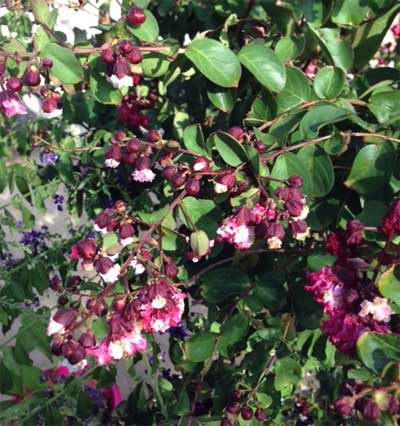
Answer: It’s an interesting phenomenon. It happens when cloudy weather coincides with flower buds opening. I see it also in nursery trade shows in the summer, when crape myrtles are brought into sales booths in full bloom. They’re beautiful the first day, but sprinkled with white petals by the time of Sunday show tear-downs.
Question: This mountain laurel was planted three years ago. About three months ago it started leaning one direction, almost as if the soil ball had shifted. It was staked, and then it fell the other direction. There are other healthy trees around it. What should we do? J.J., Parker County.
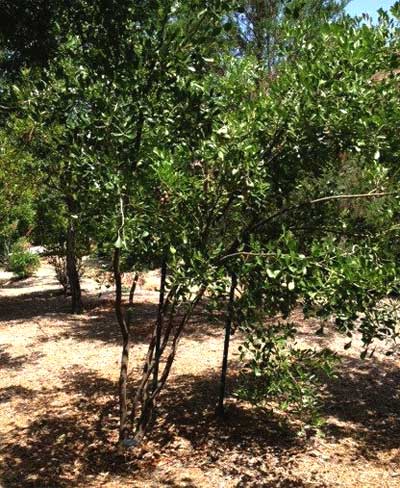
Answer: You may be correct on your diagnosis. It might have shifted at a time when the soil was very moist. It looks like the “downhill side” might have a lot more top growth. I can’t tell for sure, but it looks like there might be enough shade to have caused it to produce foliage unevenly. I guess you could dig and reset the plant vertically in February. However, if my shade thought is correct, it’s probably just leaning because of its growth toward the sunnier side. Prune to remove 20 to 30 percent of the top growth, predominantly from that heavy side. For the record, when you stake a new tree or large shrub, it’s imperative that you stake it from at least three directions, equally spaced. Leave the stakes in place for a couple of years.
Question: Last December the city replaced some curbs on our block. They planted sod to cover the bare ground. I figured out this year that it is St. Augustine. I have shade from a Shumard red oak, so I decided to keep the free row of St. Augustine, even though my lawn is a mix of fescue and bermuda. Will it crowd out my other two grasses eventually? How quickly? S., Arlington
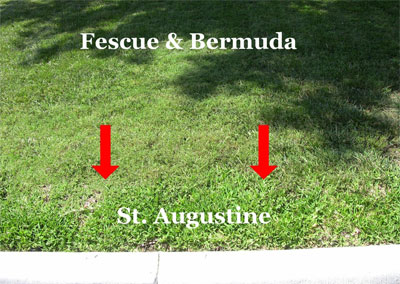
Answer: St. Augustine trumps both fescue and bermuda, although the stand will probably never be pure. Its rate of cover will depend greatly on the water and fertilizer you give it. I have St. Augustine that now grows 40 feet from where it got “planted” with some leftover topsoil probably 20 years ago.
Question: This weed is all over my front yard. It has a very pungent smell when mowed. No weedkiller that I have applied has caused it to wilt, much less die. It has very thin leaves and grows close to the ground. What can I do to get rid of it? P.H., Murphy.
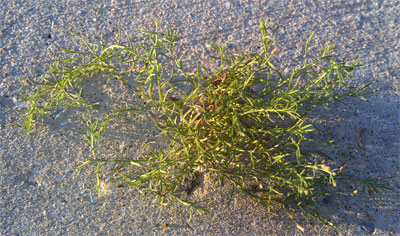
Answer: Broadleafed weedkillers containing 2,4-D should control this and almost any other non-grassy weed. Most commonly these herbicides will also contain a couple of other active ingredients, and one or both of those may be active through the soil, so be cautious in using them where there are tree and shrub roots in the same soil. Most independent retail garden centers have one or two products containing only 2,4-D. Apply these materials to very active growth. The more leaf surface that is present and the more vigorously the weed is growing, the better the control will be. Add one drop of liquid dishwashing detergent with each gallon of mix to get the spray to stay in place on the leaf surfaces. Pump sprayers are much better than hose-end types for this use. For the record, I am not sure of this weed’s exact identification, but the control and technique that I’ve suggested are your best options. Also, if you are able to ramp up the vigor of the lawn, it should be able to crowd out most of the weed growth on its own.


